3D Numerical Simulation of Rock Cutting of an Innovative Non-Planar Face PDC Cutter and Experimental Verification
Abstract
1. Introduction
2. Introduction to 3-RDE Cutter
3. Numerical Methodology
- (1)
- The cutter is regarded as a rigid body, regardless of the effect of detail configurations, i.e. round borders or chamfers, of the cutting edges.
- (2)
- The influences of temperature, confining pressure, and drilling fluid are neglected.
- (3)
- When the rock element fails, it’s removed from the rock body immediately, ignoring its impact on the subsequent cutting.
- (4)
- Simplify the circular cutting motion to a linear cutting one [15]
- (5)
- The rock is continuous isotropic medium, ignoring the effects of initial cracks and internal pressure.
3.1. Strength Criteria and Failure Analysis of Rock
3.2. Finite-Element Model of the Cutter-Rock System
3.3. Cutting Performance Evaluation Index
4. Model Verification
5. Results and Discussion
5.1. Comparison of Rock-Breaking Mechanism of 3-RDE Cutter and Conventional Cutter
5.2. Effect of Back-Rake Angle
5.3. Effect of Cutting Depth
5.4. Effect of Rotational Angle
5.5. Effect of Rock Properties
6. Field Application
7. Conclusions
- (1)
- Due to the different shape, the rock breaking mechanism of conventional PDC cutter is mainly shear failure, while the 3-RDE cutter not only shears the rock in the same way as the conventional cutter, but also delivers a crushing action similar to a roller cone insert with a higher rock breaking efficiency. The cutting edge and working face of conventional cutter synchronously interact with the rock, while the 3-RDE’s convex edge and working surfaces asynchronously break the rock. The forces required by the 3-RDE cutter are smaller, and the cutting process is more stable and efficient.
- (2)
- The cutting forces and their fluctuations, as well as MSE, of 3-RDE cutter increase with the increase of the back-rake angle. A small back-rake angle should be selected for the design.
- (3)
- With the increase of cutting depth, the cutting forces and their fluctuations, as well as MSE, of 3-RDE cutter increase. Reasonable cutting depth facilitates the rock breaking.
- (4)
- With the increase of the rotational angle, the cutting forces and theirs’ fluctuations, as well as MSE, of 3-RDE cutter increase gradually. When designing or manufacturing the 3-RDE PDC bit, the rotational angle should be set at 0° to ensure that the 3-RDE cutter’s convex edge is perpendicular to the rock surface.
- (5)
- Simulation results and field trials show that compared with the conventional cutter, the 3-RDE cutter is easier to penetrate into the formation and more stable with less torque required. The use of 3-RDE cutter in hard abrasive heterogeneous formation can achieve a higher ROP and save costs.
Author Contributions
Funding
Conflicts of Interest
References
- Crane, D.; Zhang, Y.; Douglas, C.; Song, H.; Gan, X.; Lin, Z.; Mueller, L.; Skoff, G.; Self, J.; Krough, B. Innovative PDC Cutter with Elongated Ridge Combines Shear and Crush Action to Improve PDC Bit Performance. In Proceedings of the SPE Middle East Oil & Gas Show and Conference, Manama, Kingdom of Bahrain, 6–9 March 2017. [Google Scholar]
- Li, X.B.; Summers, D.A.; Rupert, G.; Santi, P. Experimental investigation on the breakage of hard rock by the PDC cutters with combined action modes. Tunn. Undergr. Space Technol. 2001, 16, 107–114. [Google Scholar] [CrossRef]
- Che, D.; Ehmann, K. Experimental study of force responses in polycrystalline diamond face turning of rock. Int. J. Rock Mech. Min. Sci. 2014, 72, 80–91. [Google Scholar] [CrossRef]
- Xu, C.; Gong, X.; Zhang, W.; Chen, G. An Investigation on Eddy Current Pulsed Thermography to Detect Surface Cracks on the Tungsten Carbide Matrix of Polycrystalline Diamond Compact Bit. Appl. Sci. 2017, 7, 429. [Google Scholar] [CrossRef]
- Yarali, O.; Kahraman, S. The drillability assessment of rocks using the different brittleness values. Tunn. Undergr. Space Technol. 2011, 26, 406–414. [Google Scholar] [CrossRef]
- Almasi, S.N.; Bagherpour, R.; Mikaeil, R.; Ozcelik, Y. Developing a new rock classification based on the abrasiveness, hardness, and toughness of rocks and PA for the prediction of hard dimension stone sawability in quarrying. Geosyst. Eng. 2017, 20, 295–310. [Google Scholar] [CrossRef]
- Che, D.; Han, P.; Guo, P.; Ehmann, K. Issues in Polycrystalline Diamond Compact Cutter–Rock Interaction From a Metal Machining Point of View—Part II: Bit Performance and Rock Cutting Mechanics. J. Manuf. Sci. Eng. 2012, 134, 064002. [Google Scholar] [CrossRef]
- Hussein, A.; Al-Anezi, N.A.; Al-Sarraf, A.Q.; Dhabria, A.K.; Baqer, H.A.; Maliekkal, H.; Ghoneim, O.; Zhang, Y. Thermally Stable Cutter Technology Advances PDC Performance in Hard and Abrasive Formations, Kuwait. In Proceedings of the International Petroleum Technology Conference, Beijing, China, 26–28 March 2013. [Google Scholar]
- Schell, E.J.; Phillippi, D.; Fabian, R.T. New, Stable PDC Technology Significantly Reduces Hard Rock Cost Per Foot. In Proceedings of the SPE/IADC Drilling Conference, Amsterdam, The Netherlands, 19–21 February 2003. [Google Scholar]
- Clegg, J.M. Faster, Longer, and More Reliable Bit Runs With New-Generation Thermostable PDC Cutter. In Proceedings of the SPE Annual Technical Conference and Exhibition, San Antonio, TX, USA, 24–27 September 2006. [Google Scholar]
- Durrand, C.J.; Skeem, M.R.; Hall, D.R. Thick PDC, Shaped Cutters For Geothermal Drilling: A Fixed Cutter Solution For a Roller Cone Drilling Environment. In Proceedings of the 44th U.S. Rock Mechanics Symposium and 5th U.S.-Canada Rock Mechanics Symposium, Salt Lake City, Utah, 27–30 June 2010. [Google Scholar]
- Dongpeng, Z.; Tongjian, N.; Chunlin, Z.; Shanshan, M.; Haijiang, F. Multiple-cutting-edge special shaped structure polycrystalline diamond compact. China Patent CN2015211026448, 4 December 2015. [Google Scholar]
- Zou, D.; Sun, Y.; YU, P.; Hou, X.; Yang, S. Experiment study on bench test of stinger PDC bit. J. China Univ. Pet. (Ed. Nat. Sci.) 2015, 39, 48–52. [Google Scholar]
- Gumich, D.; Pak, M.; Lomov, A.; Gorobchenko, M. New Ridge Diamond Elements Improve PDC Bit Efficiency (Russian). In Proceedings of the SPE Russian Petroleum Technology Conference, Moscow, Russia, 16–18 October 2017. [Google Scholar]
- Pryhorovska, T.O.; Chaplinskiy, S.S.; Kudriavtsev, I.O. Finite element modelling of rock mass cutting by cutters for PDC drill bits. Pet. Explor. Dev. 2015, 42, 888–892. [Google Scholar] [CrossRef]
- Yang, Y.; Zhang, C.; Lin, M.; Chen, L. Research on rock-breaking mechanism of cross-cutting PDC bit. J. Pet. Sci. Eng. 2018, 161, 657–666. [Google Scholar] [CrossRef]
- Zhu, X.; Yi, Q. Research and application of reaming subsidence control in horizontal directional drilling. Tunn. Undergr. Space Technol. 2018, 75, 1–10. [Google Scholar] [CrossRef]
- Jaime, M.C.; Zhou, Y.; Lin, J.-S.; Gamwo, I.K. Finite element modeling of rock cutting and its fragmentation process. Int. J. Rock Mech. Min. Sci. 2015, 80, 137–146. [Google Scholar] [CrossRef]
- Zhang, C. Research on Rock-Breaking Mechanism and Design. Ph.D. Thesis, Southwest Petroleum University, Chengdu, China, 2018. [Google Scholar]
- Tang, J.; Lu, Y.; Ge, Z.; Xia, B.; Sun, H.; Du, P. A new method of combined rock drilling. Int. J. Min. Sci. Technol. 2014, 24, 1–6. [Google Scholar] [CrossRef]
- Teale, R. The concept of specific energy in rock drilling. Int. J. Rock Mech. Min. Sci. Geomech. Abstr. 1965, 2, 57–73. [Google Scholar] [CrossRef]
- Akbari, B.; Miska, S. The effects of chamfer and back rake angle on PDC cutters friction. J. Nat. Gas Sci. Eng. 2016, 35, 347–353. [Google Scholar] [CrossRef]
- Liu, W.; Zhu, X.; Jing, J. The analysis of ductile-brittle failure mode transition in rock cutting. J. Pet. Sci. Eng. 2018, 163, 311–319. [Google Scholar] [CrossRef]
- Trunk, P.; Nasief, M.; Shi, K.; Long, W.; Terracina, D.; White, A.; Tocantins, J.P.; Costa, E.; Louback, L.; Hird, J.; et al. Underreamer Block with Conical Diamond Elements—Concept, Design, Optimization, and Field Tests. In Proceedings of the SPE Annual Technical Conference and Exhibition, Dallas, TX, USA, 24–26 September 2018. [Google Scholar]
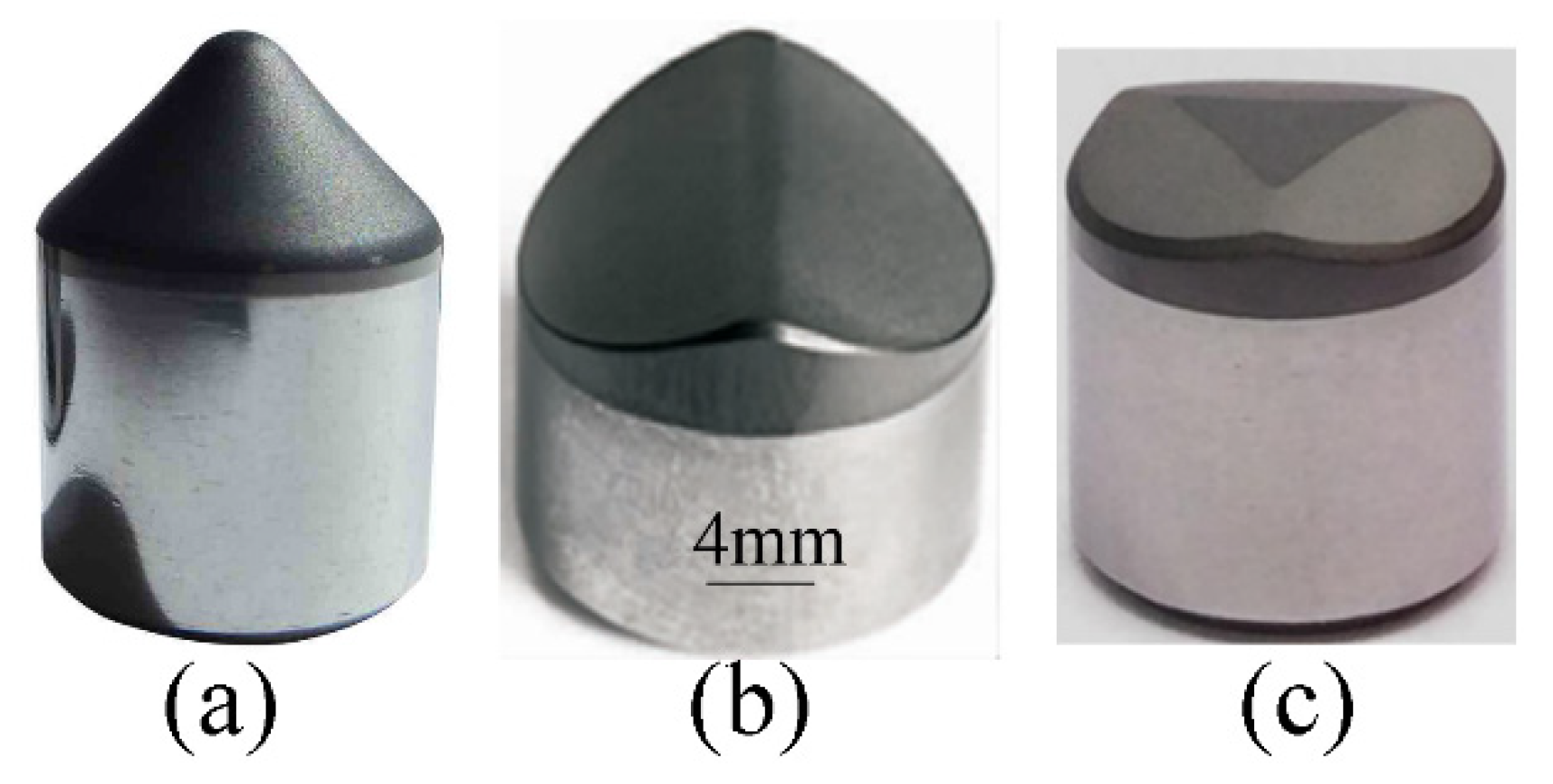
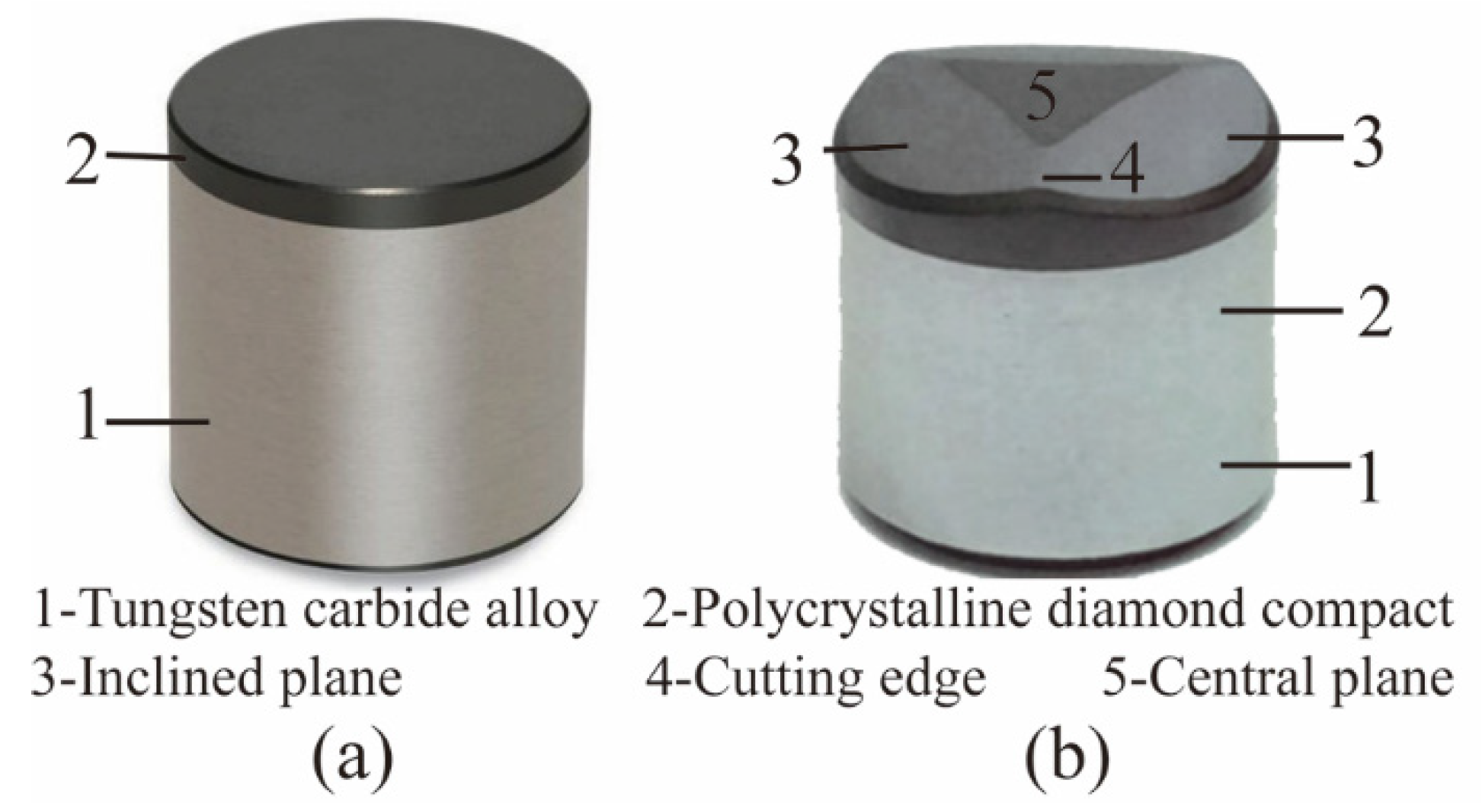

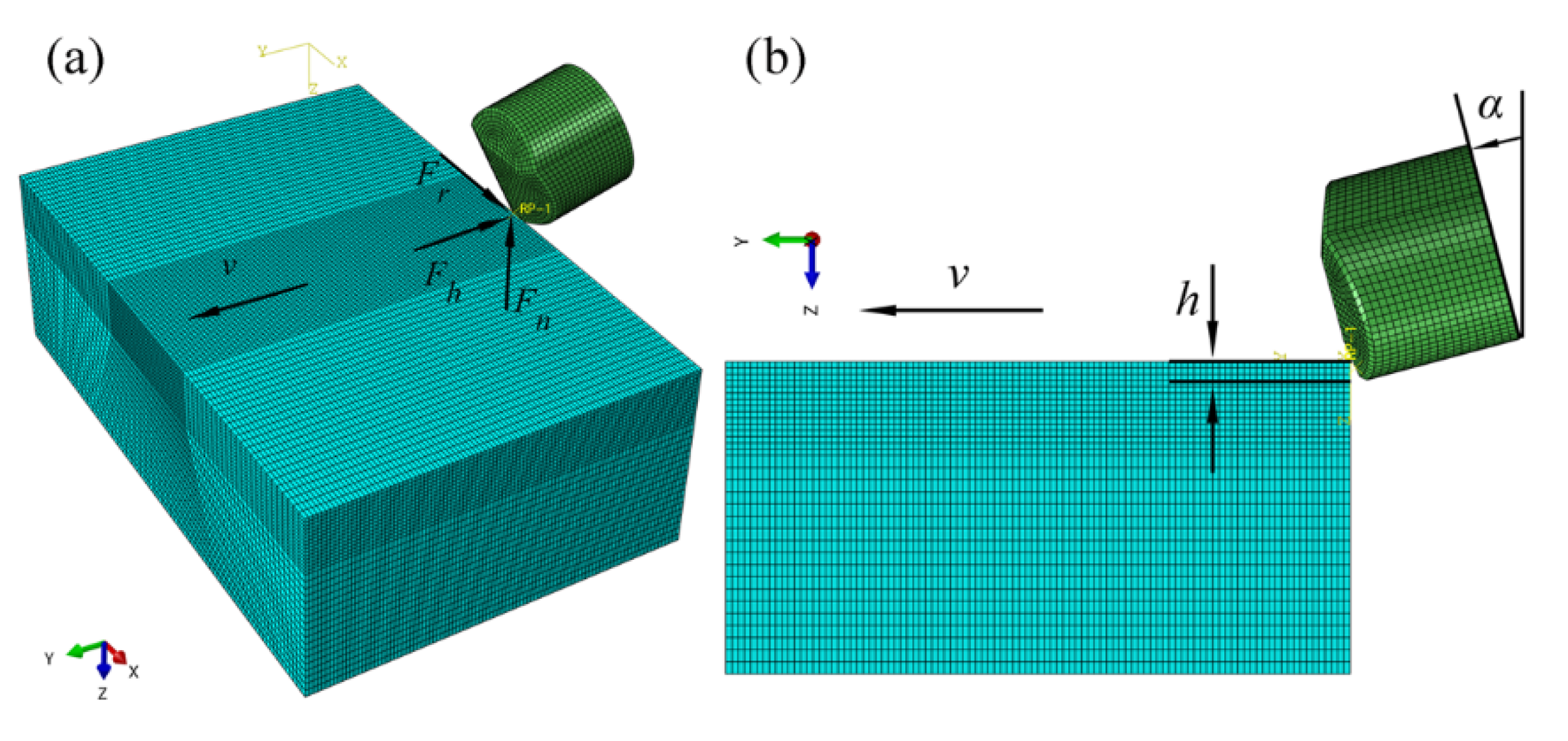

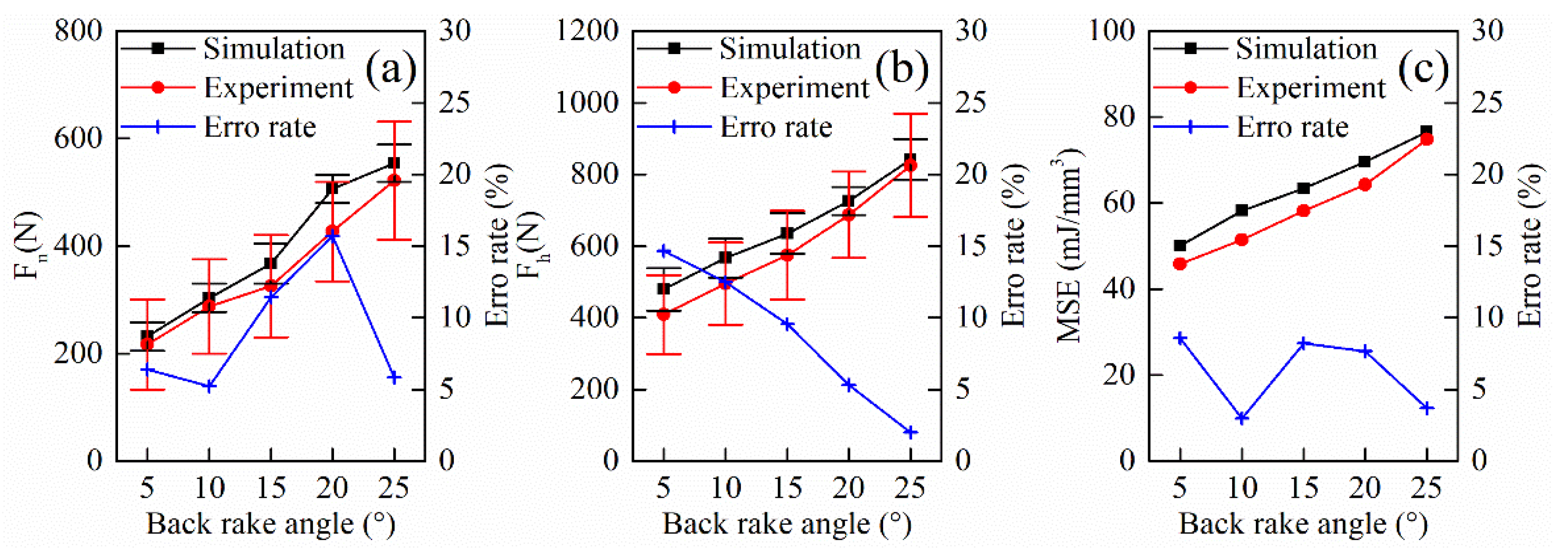

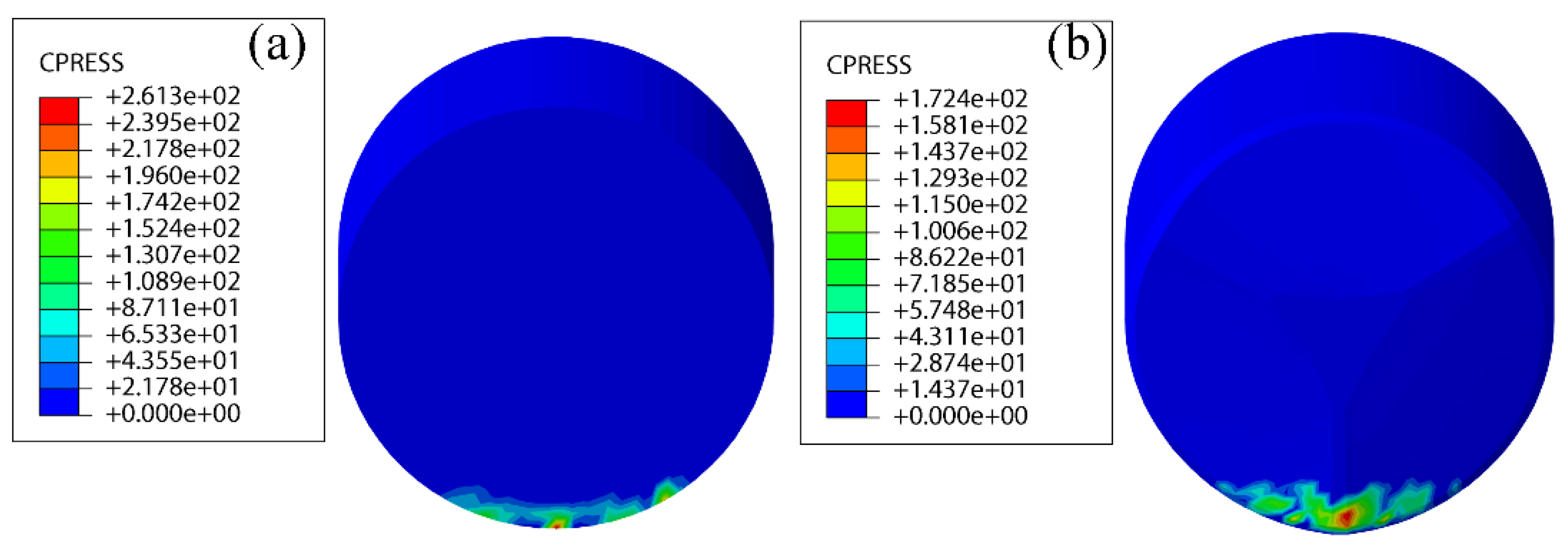

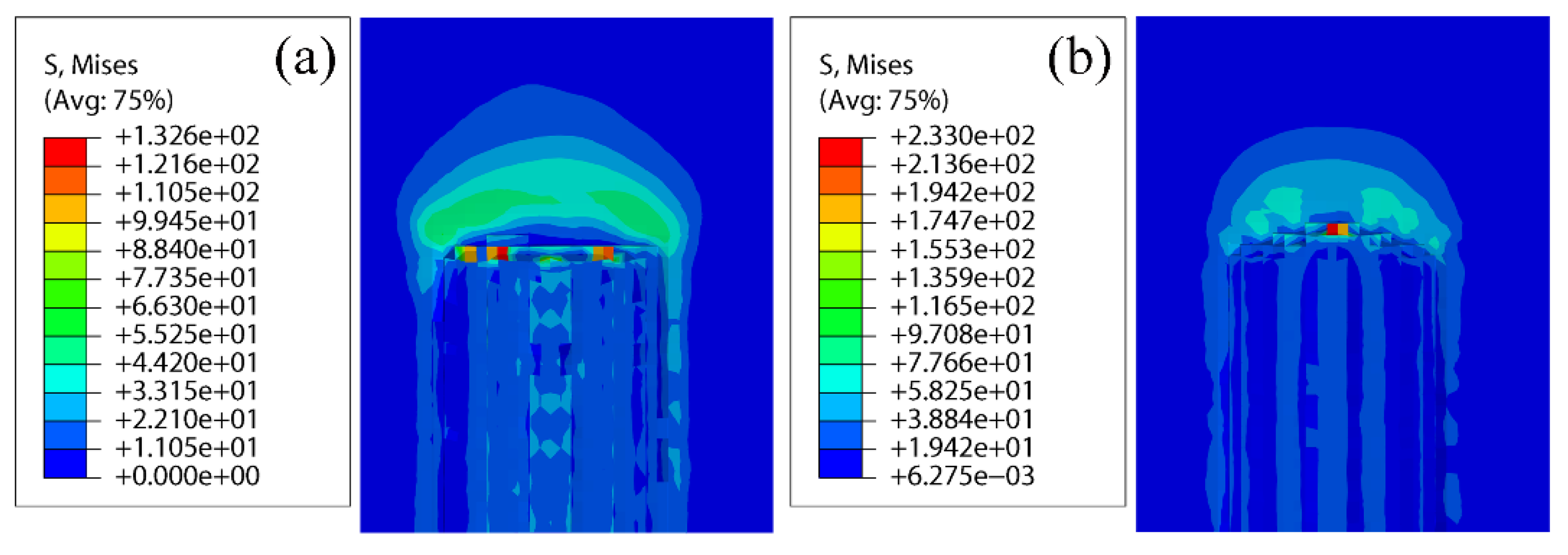
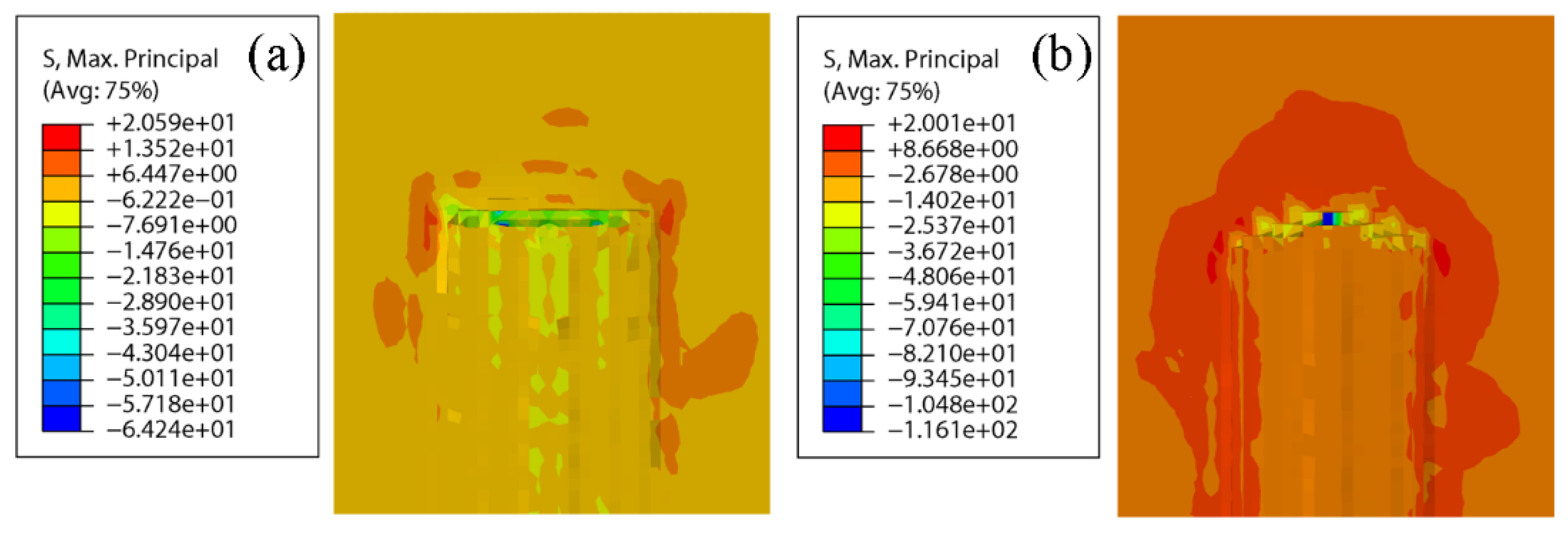
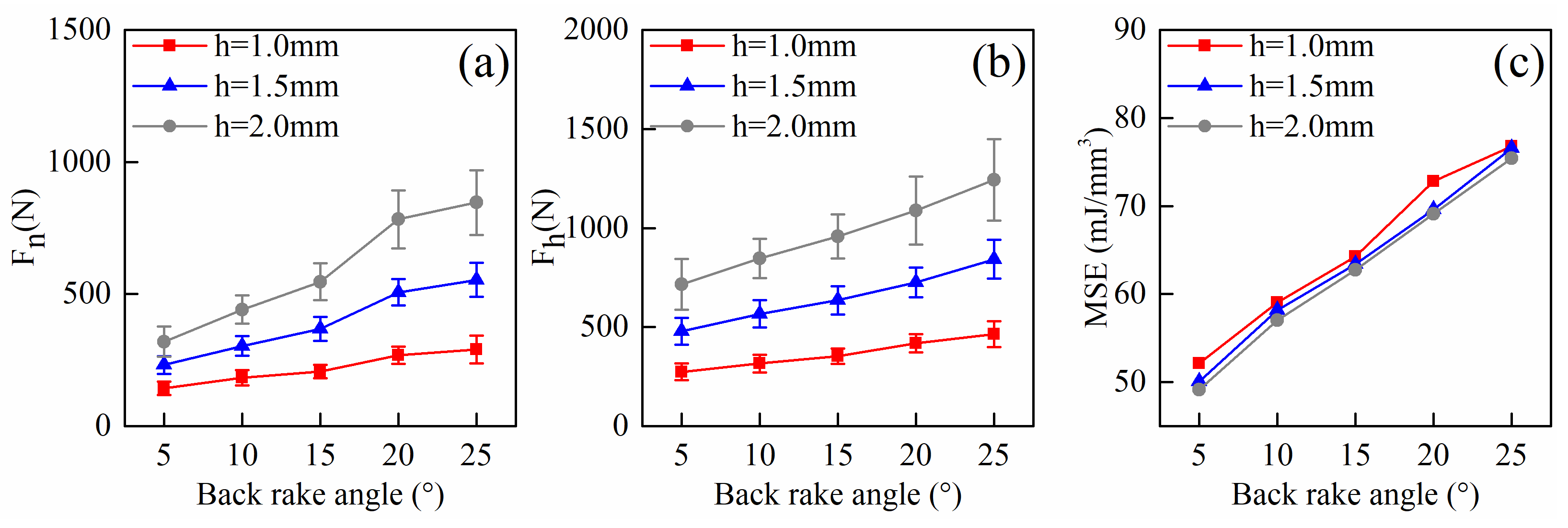

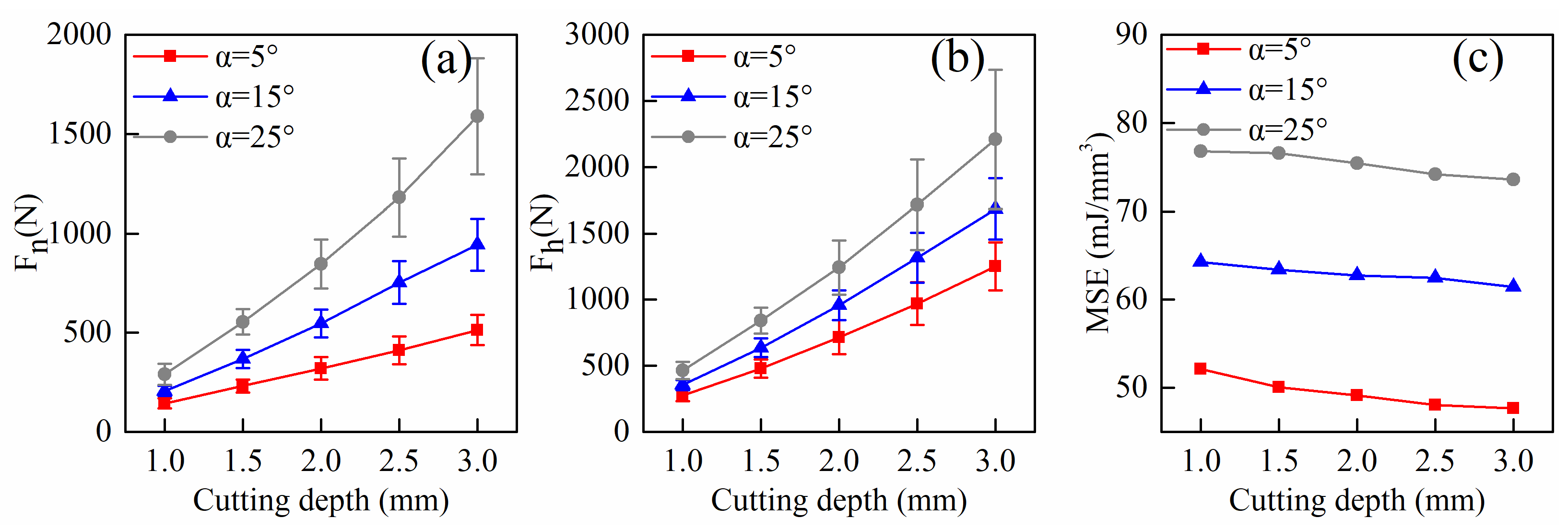
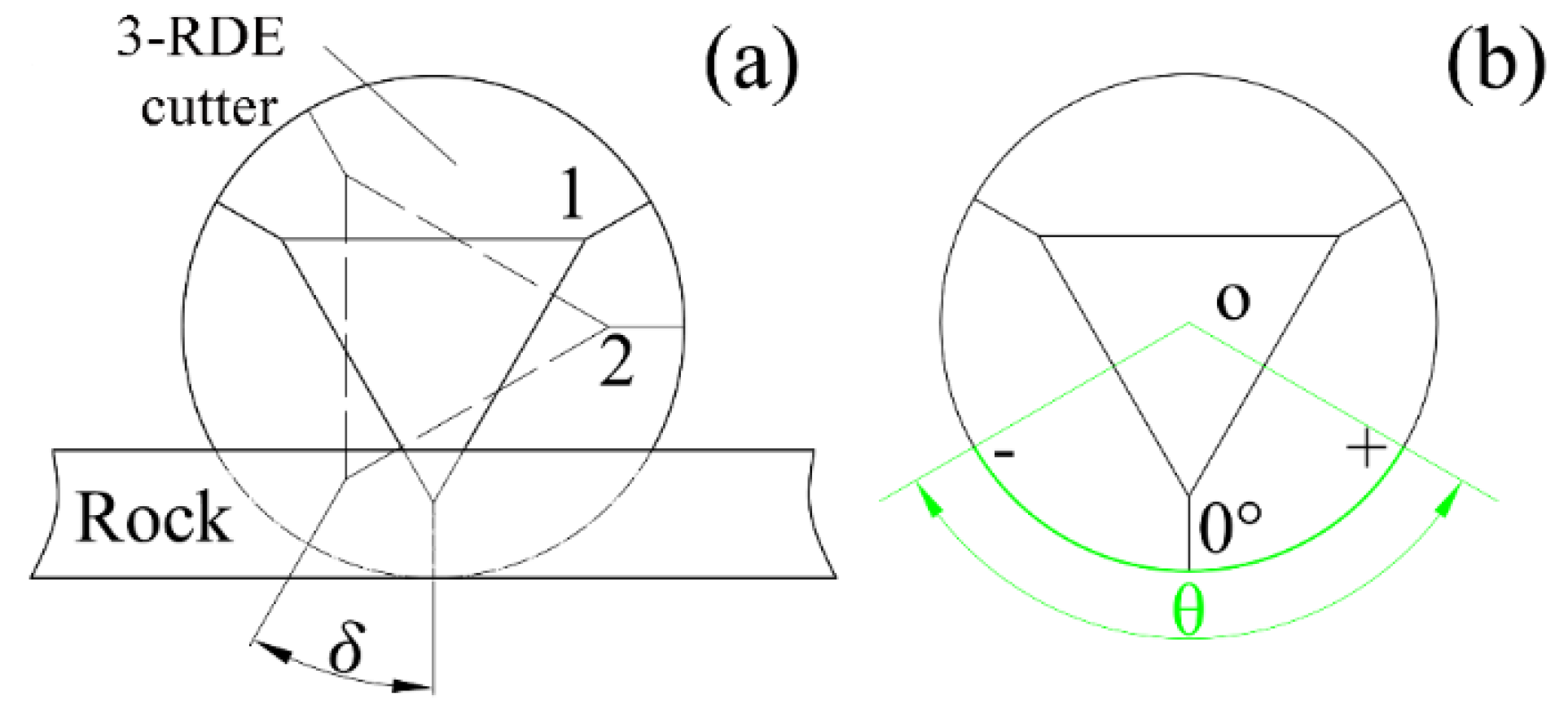

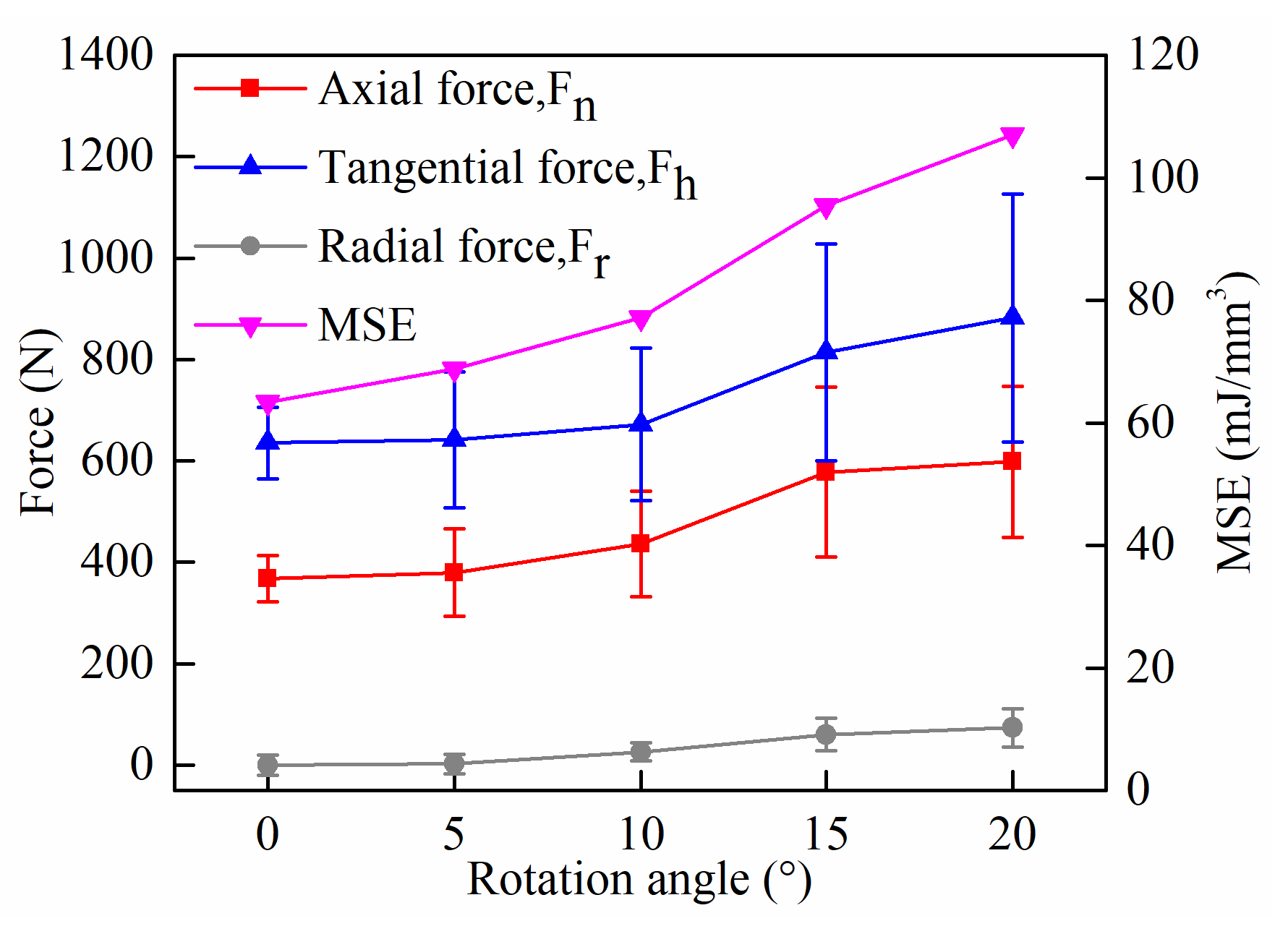
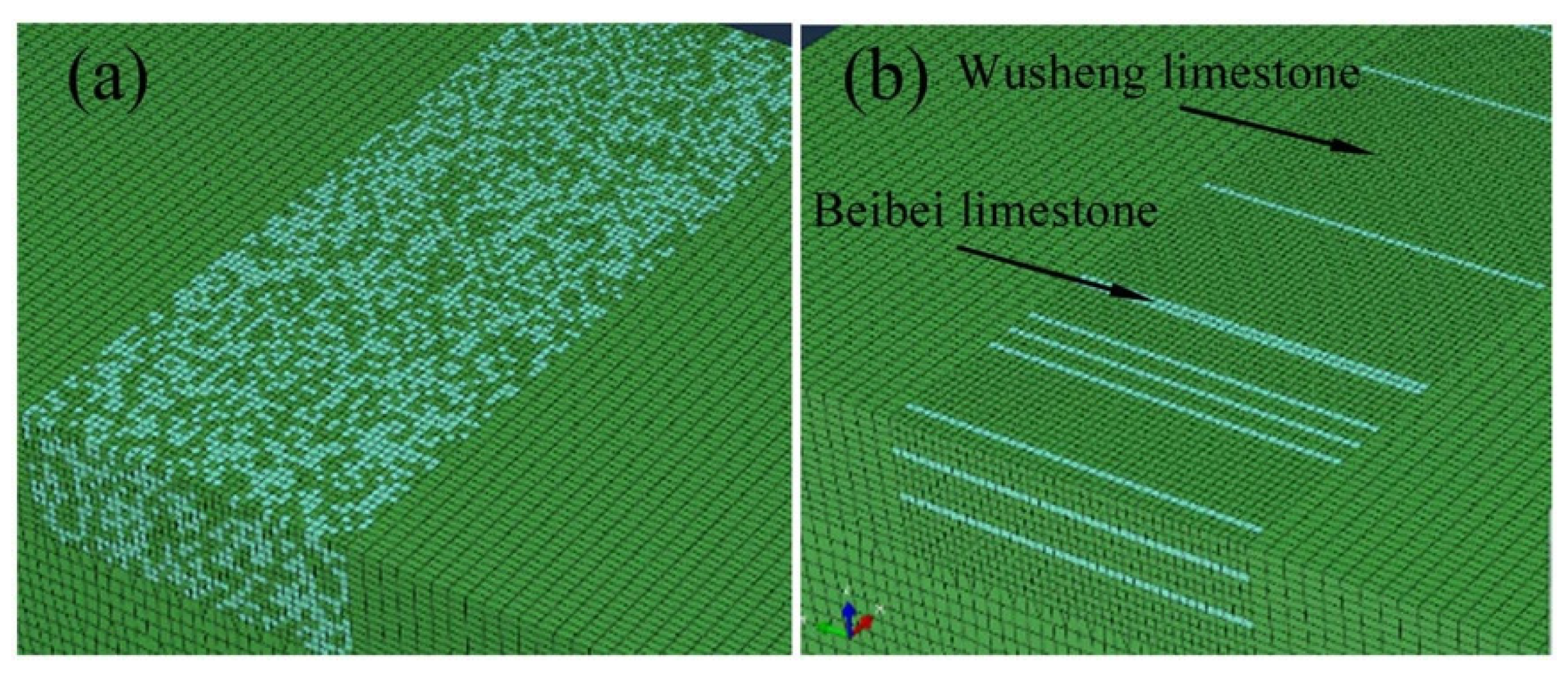
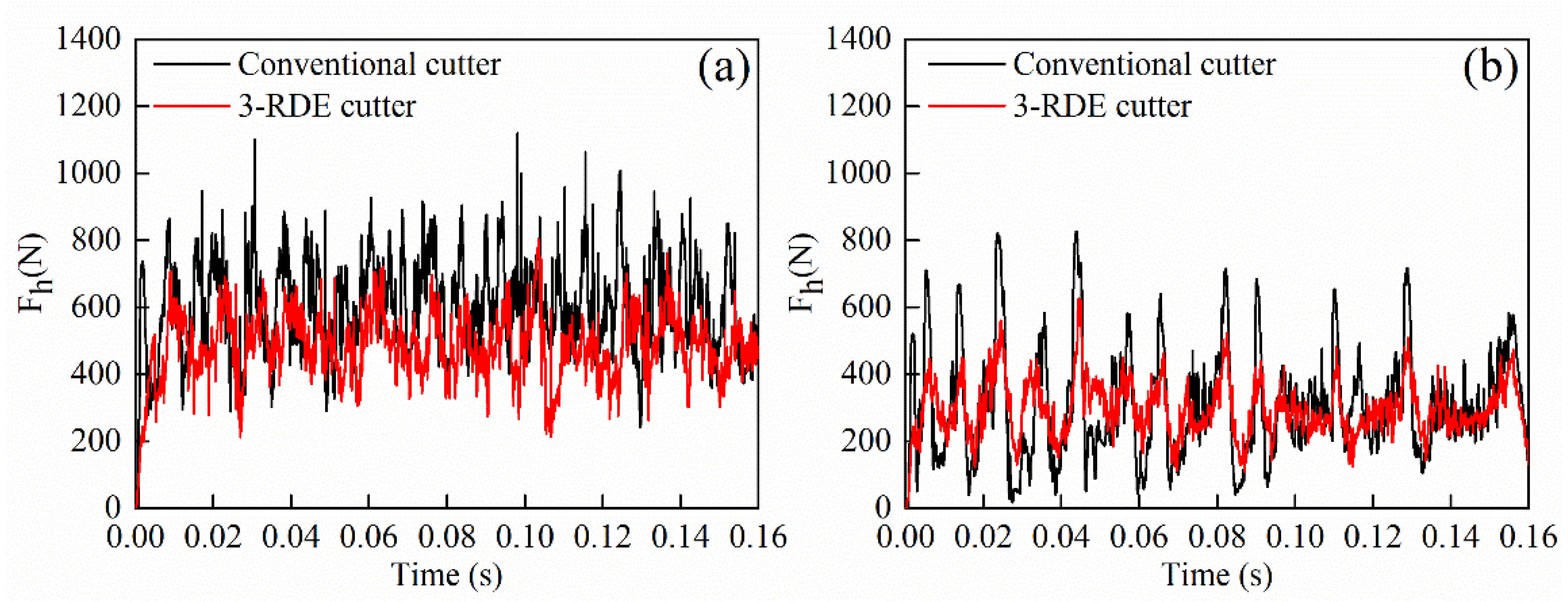
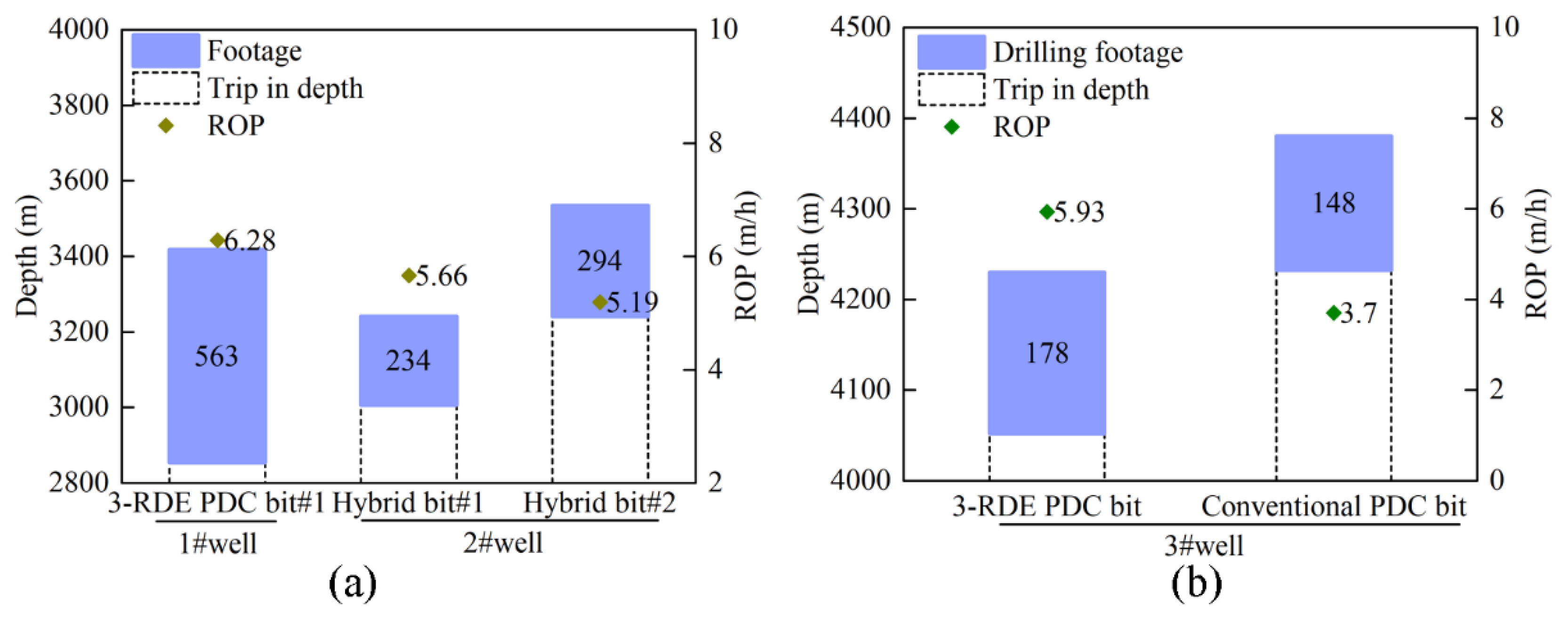
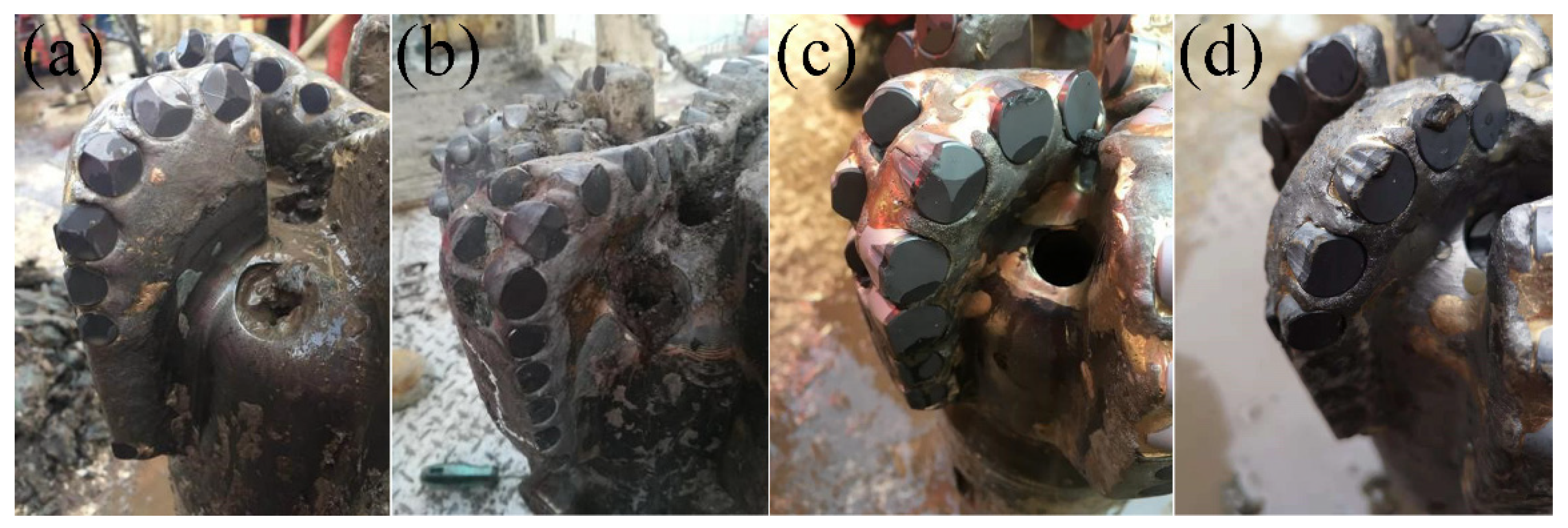
© 2019 by the authors. Licensee MDPI, Basel, Switzerland. This article is an open access article distributed under the terms and conditions of the Creative Commons Attribution (CC BY) license (http://creativecommons.org/licenses/by/4.0/).
Share and Cite
Liu, J.; Zheng, H.; Kuang, Y.; Xie, H.; Qin, C. 3D Numerical Simulation of Rock Cutting of an Innovative Non-Planar Face PDC Cutter and Experimental Verification. Appl. Sci. 2019, 9, 4372. https://doi.org/10.3390/app9204372
Liu J, Zheng H, Kuang Y, Xie H, Qin C. 3D Numerical Simulation of Rock Cutting of an Innovative Non-Planar Face PDC Cutter and Experimental Verification. Applied Sciences. 2019; 9(20):4372. https://doi.org/10.3390/app9204372
Chicago/Turabian StyleLiu, Jianxun, Hualin Zheng, Yuchun Kuang, Han Xie, and Chao Qin. 2019. "3D Numerical Simulation of Rock Cutting of an Innovative Non-Planar Face PDC Cutter and Experimental Verification" Applied Sciences 9, no. 20: 4372. https://doi.org/10.3390/app9204372
APA StyleLiu, J., Zheng, H., Kuang, Y., Xie, H., & Qin, C. (2019). 3D Numerical Simulation of Rock Cutting of an Innovative Non-Planar Face PDC Cutter and Experimental Verification. Applied Sciences, 9(20), 4372. https://doi.org/10.3390/app9204372




